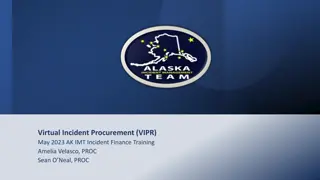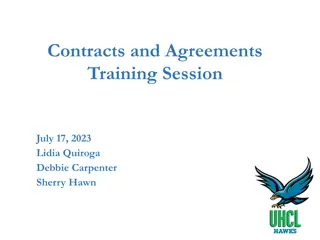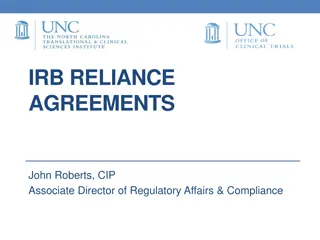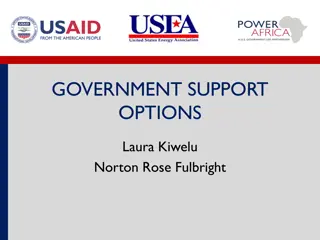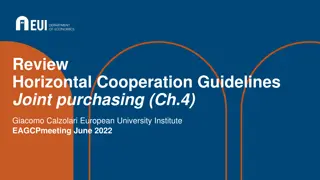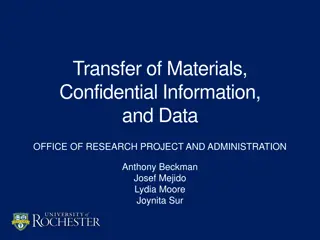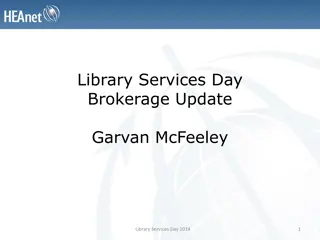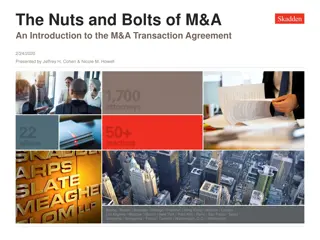Understanding Bankable Power Purchase Agreements in Independent Power Projects
Power Purchase Agreements (PPAs) play a crucial role in independent power projects, governing the sale and purchase of power between ProjectCo and the Offtaker. A bankable PPA is essential for a project to reach financial close, as it provides revenue for ProjectCo to repay funders and cover operating expenses. Project finance is necessary to raise non-recourse debt, transfer technology risk to the private sector, and attract long-term investment into the power sector. Key milestones and terms in project development include Commercial Operations Date, Financial Close, and Operating Period, among others.
Download Presentation

Please find below an Image/Link to download the presentation.
The content on the website is provided AS IS for your information and personal use only. It may not be sold, licensed, or shared on other websites without obtaining consent from the author. Download presentation by click this link. If you encounter any issues during the download, it is possible that the publisher has removed the file from their server.
E N D
Presentation Transcript
Principles of bankable PPAs Laura Kiwelu Norton Rose Fulbright LLP
What is a power purchase agreement? A PPA governs the sale and purchase of power between ProjectCo and the Offtaker. It is the central document on an independent power project (IPP). Sponsors, Lenders and the Offtaker have their own and shared objectives. A PPA is a highly technical and financial document with a lengthy term. It is essential that it is fully understood and committed to by each party. Any standardised or model PPA should be thoroughly considered and consulted on, and PPA negotiations should be constructive.
Renewable IPP structure Sponsors Lenders Government Shareholders Agreement Implementation Agreement ProjectCo Offtaker PPA O&M Agreement EPC Contract Lease Operator EPC Contractor Land Owner
What is bankability? If a contract is bankable it means that it is sufficiently robust to enable a project to reach financial close. The PPA is crucial to bankability as it is the source of revenue for ProjectCo. If no revenues flow under the PPA then there are no funds to repay Funders and to pay operating expenses. The concept of bankability is fluid and evolves as power markets evolve and new technologies become known. As project finance is usually focused on a single SPV and a single Plant, the quality of the project documentation in supporting ProjectCo s ability to repay debt and operate the Plant is crucial.
Why is project finance necessary? Project finance is required by Sponsors to raise non-recourse or limited recourse debt. The usage of project finance enables the transfer of technology risk to the private sector and takes the financing burden away from Government. Establishing a robust framework for IPPs is a strong move towards a liberalised and self-supporting power sector. The availability of permanent financing (i.e. debt with a grace period equal to the construction period plus a repayment period of at least 10 years) on reasonable terms and conditions is a key pre-requisite to attract long-term investment from the private sector into the power sector in Sub-Saharan Africa
Term and milestones Commercial Operations Date Financial Close Operating Period Construction Period Development Period (18 + months) (20 30 years) (@12 36 months) Permitting / authorisations Contracting (PPA, IA, EPC, O&M etc) Financing Studies ESIA CPs Advisers Land Equity risk period Construction completion risk EPC contractor support PPA performance bond Testing and commissioning Interconnection Deemed completion EPC & ProjectCo primary obligations O&M obligations Offtaker credit support effective Reserve accounts ProjectCo, O&M and Offtaker primary obligations
Construction and commissioning ProjectCo will construct the Plant in accordance with laws, permits and good industry practice. ProjectCo will provide and maintain the Performance Bond. The Offtaker must have sufficient notice of synchronisation and commissioning for scheduling reasons. Monthly construction reports. Pass through to EPC contractor. The role of the Independent Engineer is essential as the Independent Engineer will certify COD by issuance of a certificate to both parties.
Commercial Operations Date Anticipated COD Required COD Longstop COD Programmed COD from time to time (floating). Base date for deemed completion? Fixed x months from Effective Date. Triggers Delay liquidated damages (LDs) Fixed x months from Required COD. Triggers default and termination Delay LDs: payable by ProjectCo for each day of delay. Must be based on the Offtaker s wasted costs and losses. Capped. Capacity shortfall LDs: payable by ProjectCo for failing to achieve contracted capacity. Based on Offtaker s loss. Capped.
Interconnection The structure of interconnection arrangements must be clear from an early stage as this structuring will impact the tariff and may cause delay Offtaker to construct? ProjectCo to construct? Both? Offtaker must accept the commissioning energy and take necessary steps to enable interconnection and commissioning to take place. Failure of Offtaker = deemed completion.
Sale and purchase of power What power is being sold? Contracted capacity? What about commissioning energy? Sale of capacity or metered output only? Where is the delivery point? Is it exclusive?
Tariff The tariff must be clearly and unequivocally stated For non-dispatchable renewables the tariff will be energy charge only and will be stated simply as x per kWh . If the tariff is subject to indexation or escalation this must also be clear.
Metering and invoicing The metering provisions in the PPA are essential to ensure a smooth invoicing and payment process, as invoices are derived from the meter system. The PPA must be clear as to: (i) who installs and commissions each meter, (ii) who owns and operates each meter, (iii) which is the main meter and which is the back-up meter, (iv) regular testing, (v) how to deal with inaccuracies, and (vi) how meters are read. ProjectCo issues invoices. Offtaker must either pay invoices within a specified time (usually 30 days) or dispute them on a fast-track basis. No deductions and gross up. Late payment default interest. Ability to draw on credit support. Discounts for prompt payment?
Liquidity support A limited amount of cash which is on demand to ProjectCo (letter of credit, bank guarantee or escrow). A typical feature of most power trading transactions. Requirements are driven by lenders. Generally equivalent to 3-12 months of PPA revenues BUT this evolves and depends on the jurisdiction. Putting in place liquidity support often causes delay. Multilateral institution options are available - e.g. World Bank Partial Risk Guarantee, African Trade Insurance Agency (ATI) Regional Liquidity Support Facility.
Currency and foreign exchange Offtaker HCY ? ProjectCo LCY There is currently a mis-match on regional IPPs between the Offtaker s revenues (which are in local currency LCY) and the opex and debt of ProjectCo (which are in hard currency HCY). Exceptions are South Africa and Namibia and imminently Kenya. This mis-match must be carefully addressed. Undue exposure of ProjectCo to forex will increase the tariff. It is generally acceptable for the tariff to be denominated in HCY but paid in LCY so as to avoid the Offtaker incurring the additional cost of converting its LCY revenues.
Convertibility protections On each monthly payment date, ProjectCo will have revenues in LCY. ProjectCo must immediately convert to HCY for opex and debt service. In order to limit ProjectCo s monthly forex exposure, it is crucial that the conversion by the Offtaker of the energy payment to LCY takes place on the date of payment. This structure is bankable, however residual Lender concerns: (1) LCY may not be freely convertible to HCY at some point during the term, and (2) the Government may not have enough HCY reserves. The Offtaker / Government must therefore provide convertibility support by way of an indemnity in respect of shortfalls due to a short-term inability to convert and an obligation to make HCY available if there is a scarcity. The Government must also ensure that ProjectCo can repatriate revenues. Catastrophic inability to convert or repatriate? PRI cover is available . but at a cost.
Deemed energy The Offtaker must accept and pay for the energy which is delivered to the delivery point. Where the tariff is energy charge, ProjectCo would receive no revenue if there is a prolonged curtailment. Deemed energy covers this risk deemed energy is the energy that the Plant is deemed to have generated during a curtailment event. There are various methods for calculating deemed energy, but the method chosen must be simple and fair. What risk can ProjectCo accept availability of contingent risk insurance to cover loss of revenue from events affecting the grid?
Means of limiting deemed energy Annual threshold of hours of allowed grid outage (usually around 100 hours). An annual cap on deemed energy when aggregated with actual production (usually set at P50) to ensure that the developer is not over-compensated during a contract year of good generation followed by a curtailment. Bankable Discounted deemed energy tariff? Different treatment if grid issue is caused by force majeure? Term extension? Deducting deemed commissioning amounts at the end of the term? Bankable? Excluding a number of hours per curtailment event (as this means ProjectCo would not be protected upon repetitive curtailments of short duration). No entitlement to deemed energy during commissioning or during the first year of operations. Excluding where deemed energy is caused by a political event. Unbankable
Risk allocation It is a core principle of project finance that each risk should be allocated to the party that is best able to manage that risk.
Risk allocation PPA / IA The PPA may not allocate each risk, and generally any risk that should reside with either the Offtaker or the Government which is not allocated in the PPA would be expected to be allocated in the IA. It generally varies whether the risks of change in law, change in tax or political events are allocated to the Offtaker in the PPA or to the Government in the IA. The less risk the Offtaker is able to accept, the more risk will be allocated to the Government, and therefore IA negotiations would be prolonged.
Consequences of force majeure Provided that the affected party complies with the notice requirements in the PPA, it should be relieved from its obligations and milestones should be extended for the period it is affected by the force majeure. Force majeure affecting a contractor should entitle ProjectCo to relief under the PPA. Economic hardship is not a force majeure and payment obligations are not excused by the occurrence of a force majeure. Similarly, breakdown of plant and equipment or general contractor delay is not a force majeure. Prolonged force majeure (i.e. 6-12 months) is a termination event.
Change in Law Change in Law is an introduction of a new law / modification of an existing law / changes in interpretation of a law / lapse of a permit after the signature date which: adversely affects ProjectCo s performance / renders performance impossible; adversely affects ProjectCo s revenue stream; requires ProjectCo to incur one-off capex / ongoing opex increase; or conversely reduces ProjectCo s capex or opex. Change in Law may have a positive or negative effect on a project s economics. ProjectCo should be in no better or worse position due to a Change in Law. Materiality thresholds? Change in Law affecting Funders? Change in Law is a Political Event (time relief) but also a standalone event (revenue and costs relief). ProjectCo should be entitled to either direct compensation or an increase in the tariff, or a reduction of the tariff.
Performance During the operating period each party must operate and maintain its assets in accordance with law, permits and good industry practice. The regime for performance testing depends on the project specifics and the Offtaker s requirements for that project. Generally no output guarantees for renewables instead availability or performance ratio testing. Testing against forecast? Accuracy of forecasting is improving (e.g. Kenya). Capped LDs for failure to meet required thresholds; ProjectCo event of default if unremedied prolonged failure. Force majeure, political events and Offtaker or Government breach must be excluded from testing.
Taxes and incentives the fiscal regime An uncertain fiscal regime causes delay to signing PPAs and setting the tariff. Which reliefs and exemptions apply to the Project? Best practice is to set out the applicable tax regime as a schedule to the PPA this sets a clear day one position and movement from this is a Change in Tax. Communication between the tax authority, the investment centre, the Offtaker, the central bank and Government is crucial.
Events of default Abandonment Failure to start construction? Failure to achieve COD Prolonged failure to perform Change in control? Seller Events of Default Failure to pay Failure to provide credit support Government breach? Catastrophic change in law? Sector restructuring? Expropriation? Buyer Events of Default Insolvency Misrepresentation Assignment Material breach Mutual Events of Default
Dispute resolution and governing law Expert Determination Escalation Arbitration International arbitration (ICC, LCIA, UNCITRAL) with a foreign seat is essential, however the arbitration may be located in close physical proximity (e.g. Johannesburg or Mauritius). Local governing law of the PPA and IA is generally acceptable. There must be a waiver of sovereign immunity by the Offtaker.
Example - Egypt Onshore seat of arbitration was the rationale for the international financial community not to support Round 1 of the Feed-in Tariff Programme (2015/16). All precedent transactions in Egypt had employed a London seat of arbitration. The tariff for Round 1 was $c13.34/kWh Egyptian Electricity Transmission Company wanted to use the Rules of the Cairo Regional Centre for International Commercial Arbitration (CRCICA) to settle disputes under the project agreements Seat of arbitration and location of any physical hearings was to be Cairo, to reduce dispute resolution costs for EETC Conditions for annulment are similar to other jurisdictions E.g. no / invalid arbitration agreement; failure to follow procedures; right to a fair hearing Public policy is a general caveat Appeal on point of law is common grounds for challenge Final solution Egyptian law does not permit re- examination of merits Annulment available for lack of jurisdiction (i.e. no arbitration agreement) or procedural impropriety, or contrary to previous Egyptian court decision or contrary to public policy Challenge risk In Round 2 the seat of arbitration was Paris, France. Egyptian courts have historically demonstrated independence from the State E.g. Court decision to nullify a maritime border treaty with Saudi Arabia Recognised by academics as generally respecting the rule of law Concern that courts could intervene and exercise jurisdiction in a biased manner Making an award that prefers EETC to the project company Bias The tariff for Round 2 was $c8.4/kWh Precedent for use of Paris seat of arbitration Fee caps for arbitrators disincentives properly qualified arbitrators Difference between CRCICA Rules and other institutional rules (no time limit for award; no expedited procedure; no consolidation) Production sharing contracts have all used Cairo seat and CRCICA Rules 2010 rules relaxed fees to attract higher calibre arbitrators for large disputes Rules are based on UNCITRAL not viewed as materially deficient Other factors 2 7 Bank Audi Training 2018
Direct agreements Offtaker Lenders ProjectCo The primary purpose of a direct agreement is for the Lenders to step-in to ProjectCo s shoes following a ProjectCo default under either the PPA or the finance documents. The Lenders and the Offtaker s interests are therefore aligned. Direct agreements may also be used by Lenders as a tool to amend the PPA (where the Lenders were mandated after the PPA was signed). In this situation the direct agreement operates as a form of amendment agreement. The PPA must include an ability for ProjectCo to assign its rights by way of security / charge its interest in the PPA to the Lenders.
PPA approval and execution Who needs to approve the PPA before execution? Corporate authorities and legal opinions Role of the Regulator?



